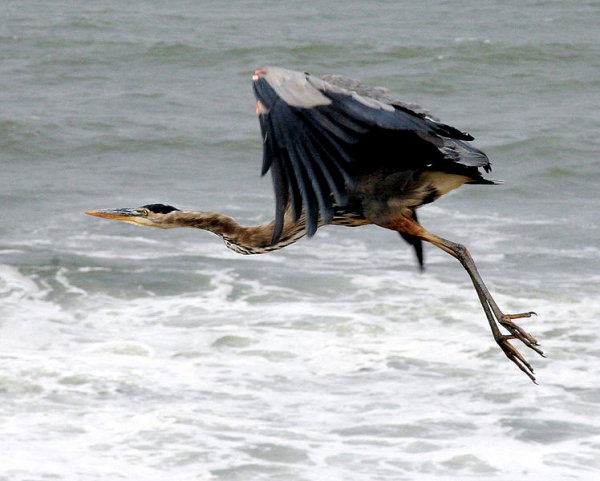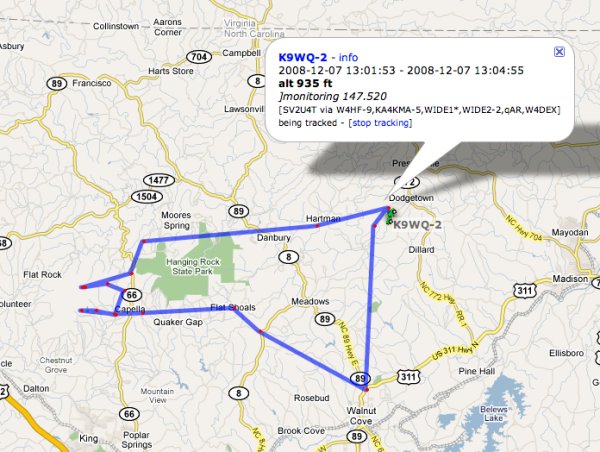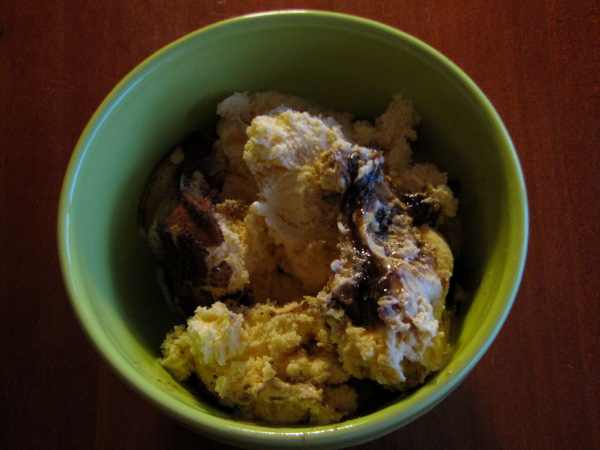
From my friend in Perpignan, here’s another installment in the series “What they’re eating in the south of France.” Above: a breakfast/lunch baguette with cheese and salad, with coffee.
Month: December 2008
Winter: Greener than I'd imagined
I was away from North Carolina for 17 years, so I’d forgotten that the local flora is by no means completely dead during the winter. We’ve had a series of warm, wet days, but we’ve also had many nights with lows in the low 20s, with the lowest temperature I’ve recorded so far 16.3F. Not only has a lot of my new grass stayed green during the winter, it’s actually grown a little.
Peppermint can’t be beaten down.
Clover slows way down in the winter, but it winters over, green.
I don’t know what this is, but I have a lot of it, and it thrives during the winter.
In this spot, two bales of straw that defended a raw ditch this spring are now melting into the grassy soil.
Past one of the arbor vitae trees (planted in March), something wicked this way comes.
The straw covers the area where the final grading around the house was done in late October. This newest grass planting has made slow progress all winter.
Yum… Fritters…
I think I found a use for those dry hummus mixes. They’re healthy, and they store well, and they make good earthquake or ice storm food for the cupboard, but they’re terrible hummus. Only fresh hummus is worthwhile. However, these mixes make a good binding for vegetable fritters. The fritter above is chopped broccoli, chopped cauliflower (both cooked until just tender) and chopped onions. The vegetables are bound with the instant hummus, and I added egg to make the fritters set from the heat of the frying pan. Fritters are real nice to have when you’ve just got to have something a bit crunchy and fried. These fritters are low carb, low glycemic, and cruciferous to boot. It shouldn’t be hard to make a vegan version if you can find a suitable substitute for the egg.
Dang, what a big bird

A great blue heron (Wikipedia)
I got out of the Jeep in the driveway in front of my house earlier today, and the biggest bird I’ve ever seen lifted off from the front gable of my house and lumbered out over the woods like an overloaded 747. It was huge, with a five-foot wingspan or more. It almost certainly was a great blue heron. If a stork on one’s roof is a sign of good luck, I believe I’ll assume that a heron is good luck too.
I have a lot of work to do learning to recognize bird species. A few days ago I saw a pileated woodpecker. They too are an impressive bird, and they make a wild, gooney-bird sound in the woods.
It speaks well of the health and variety of the local habitat that such a wide range of species can be seen here. I was amused, listening to Bill Moyers interview Michael Pollan recently, to hear Pollan say that in areas where there is an overpopulation of white-tail deer (like here), hunting them and eating them is good food policy. From bears to foxes, we’ve got them here. The little streams seem healthy, with plenty of minnows and tadpoles this spring.
The heron left a heron-size poop streak on the roof of the house.
A nice carpenter gothic
This is Rockford Methodist Church, built in 1913. It’s in the little town of Rockford, close to the Yadkin River. Note the chimney. Not all old wooden churches of this vintage have chimneys. I have not been inside this church, so I don’t know what kind of stove might be, or might have been, inside.
Lady Windermere's Fan
Have you ever been to a high school drama production that wasn’t fun? I thought not. What’s that? Some of you say you haven’t been to a high school drama production? Then you have missed an important piece of Americana.
The local high school did “Lady Windermere’s Fan,” and a young neighbor who had the role of Lady Plymdale invited me to go.
What magic, to be so young, rather the the Wildean old curmudgeon that some of us are.
“We are all in the gutter, but some of us are looking at the stars.”
— Oscar Wilde, Lady Windermere’s Fan
Improvements in the 'Where's David' GPS system

The track I followed today to Walnut Cove, then to Sauratown Mountain (getting lost on the way), then back home past Hanging Rock State Park and through Danbury.
I’ve made some improvements in my “Where’s David” GPS system that make it practical for me to use the system any time the Jeep is on the road.
The old system used a Garmin eTrex Legend handheld GPS device. When I wanted to use it, I had to make sure the Garmin device’s batteries were charged, put it in the back window of the Jeep, and plug it into the VHF transceiver. I wanted a system permanently hooked to the Jeep and drawing the Jeep’s power, the same way the VHF transceiver is hooked up.
The GPS device I previously used, now retired — a Garmin eTrex Legend
The new GPS device — a Trimble Placer 450
The new GPS device, a Trimble Placer 450, is made for permanent installation in vehicles. The devices are made for the commercial fleet-tracking market. I connected it to the Jeep’s wiring, and it’s safely mounted in the trunk of the Jeep along with my VHF transceiver. The Placer unit also has an exterior antenna, so it gets stronger signals from the GPS satellites
The Placer GPS unit’s satellite antenna, outside on the back of the Jeep
The control panel for the VHF transceiver is mounted above the windshield
The VHF transceiver’s antenna is on a short mast on the back of the Jeep
How it works: The Placer GPS unit monitors the Jeep’s position, speed, heading, and altitude. The Placer GPS unit constantly sends this data to the VHF transceiver, a Kenwood TM-D700, through a wired serial connection. Every so many minutes, the TM-D700 transmits an AX.25 APRS packet on a ham frequency reserved for this purpose — 144.390 Mhz. These packets are almost always heard by a ham “digipeater” or internet gateway station which puts the location information into an Internet database operated by hams. Once this is in the database, anyone can look at, and map, the data. Amateur radio transmissions, by law, are open to all who want to listen. One must have an amateur radio license to operate the VHF transceiver and make the transmissions, though. That is, a license is required to transmit, but anyone can listen. The Kenwood TM-D700 is well suited to this GPS location mechanism, because it has built-in digital capabilities, with a device called a “terminal node controller.”
About Sauratown Mountain: Stokes County has its own little mountain range, the Sauratown Mountains. Two of these mountains, Hanging Rock and Pilot Mountain, are state parks. However, one of the mountains, Sauratown Mountain, has been used for decades as a site for radio and television antenna towers. On a clear day, one can see 60 miles or more. Since VHF radio frequencies follow a line of sight, from the top of Sauratown Mountain one can communicate nicely on VHF frequencies. While I was on Sauratown Mountain this morning testing the new system, I spoke with KG4IXS, who is 16 miles northeast of Danville, Virginia, almost 70 miles away. The Kenwood transceiver can, of course, handle both digital and voice communication.
How to find David: There are a couple of links to the right here on the blog under “Where’s David?”
This just in…
Continuing in the category of who’s eating what where, here’s another shot of what they’re eating on Maui, with another cat as bonus. This is Phatboi, who I suspect got fat off of something other than pineapples and limes.
Send me your who’s-eating-what-and-where photos! But please, mind the quality of your photography. Whatever your subject is, get up as close to it as possible and frame it nicely. Attend to your foreground and background. There’s a world of difference between a photograph and a snapshot. One is art. The other is, well, practice until you learn to make art with your camera.
Homemade sauerkraut — the first tasting
The sauerkraut was put into the crocks on Oct. 29, and the first tasting was yesterday, Dec. 3, when my mother and brother were here for lunch. At that point the sauerkraut was a little less than five weeks old. I would say that it is good sauerkraut, but not the best I’ve ever tasted. The flavor was a bit too mild, and the cabbage is a bit too tender.
As for the mildness of the flavor, I believe that will take care of itself. The fermentation process will continue, and the flavor should get stronger as the winter progresses. Also, the basement of my unfinished house, where the crocks are, has been pretty cold, so the kraut is probably fermenting fairly slowly.
As for the texture, I need to do more research on this. But at least one sauerkraut article on the Web says that this has to do with the amount of salt used. Salt may inhibit the enzyme that tenderizes the sauerkraut, so there may be a tradeoff between saltiness and crunchiness. If that’s the case, next time I make kraut I will raise the salt content by .001 percent or so and try to see if there’s a just-right balance between not-too-salty and not-too-soft.
Then again, making sauerkraut at home, like making wine, is not a repeatable process. Every vintage will be different. Maybe someday I will say that the sauerkraut of ’08 was delicate and modest, reminiscent of boiled cabbage, with hints of turnip and an aftertaste of applesauce. Whereas the sauerkraut of ’09 was sassy and crisp, with the faintest aroma of wild onion and rutabaga.
Odd, isn’t it, how winemaking and sauerkraut-making are, as domestic arts, close cousins. And yet society sees one as refined and the other as coarse. But who cares what society thinks. One needs to preserve the summer’s harvest and eat and drink during the winter. Let the record also show that both arts — winemaking and sauerkraut-making — were practiced on the family farm on which my mother grew up in Yadkin County. The Yadkin Valley is now a viticultural region, so, with wine, my mother’s family was ahead of its time. As for the sauerkraut, we’ll keep plugging away.
Potato salad revisited
Sweet potato salad. No guilt necessary.
My local grocery store in Walnut Cove has North Carolina sweet potatoes on sale for 29 cents a pound. I bought some last week and baked ’em and mashed ’em with cinnamon. They were so good I went back and bought a bunch more, wondering what to do with them. An idea for an experiment dawned on me: make some sweet potato salad and try it out on my mother and brother, who were coming up for lunch on Wednesday.
Why sweet potato salad? Part of my theory of eating is that, especially at a certain age, we all should eat like diabetics even if we’re not. It’s not surprising that white potatoes are a high-glycemic food, not good for diabetics. It is very surprising, though, that sweet potatoes are a low-glycemic food, good for diabetics. The North Carolina Sweet Potato Commission claims, with good evidence, that the sweet potato is the most nutritious of all vegetables. They’re rich with Vitamins A and E, lycopene and potassium.
Thus the sweet potato is an important staple in the winter for those who, no matter how far from the Mediterranean, want to follow the Mediterranean diet. In fact, says the Washington Post, a low-glycemic diet and the Mediterranean diet are pretty much the same thing.
Now is as good a time as any to try to summarize my theory of diet and health.
1. Read Michael Pollan.
2. Adapt the Mediterranean diet to your location and tastes.
3. Follow a low glycemic diet.
4. Eat in such a way that your blood pH is neutral (you’ll need to do some research on this).
5. Keep your body’s net level of inflammation low with the anti-inflammation diet (you’ll need to do some research on this). Your overall level of inflammation can be measured with the C reactive protein test. Some doctors seem to give this test routinely, but you may have to ask for it.
6. Manage your oil and fat intake and your omega-3 omega-6 balance such that your cholesterols stay at the vein-washing, rather than vein-clogging, levels. Flax seed oil is your friend.
7. Maintain a level of fitness such that your resting pulse is below 75 beats per minute.
8. Maintain a body mass index of 23 or lower.
This is not a quirky diet. It’s not an expensive diet. It’s not a limited diet. These principles are not whims; they’re all backed up by good research. It’s easy to Google for these terms and see why these principles are important. Steps 4 and 5 will make perfectly clear what foods are good for you and what foods are not good for you.
Now, about the sweet potato salad. Make it just the same as you would make regular potato salad, but use sweet potatoes instead of white potatoes. To cook the sweet potatoes, put them whole and unpeeled on a cookie sheet, and bake them at 350 degrees for about an hour. Take them out of the oven and let them cool down. When they’re cool enough to touch, pick the skin off and cut the potatoes into cubes. This is much easier than peeling and boiling the potatoes, and the nutrients don’t get washed away.



